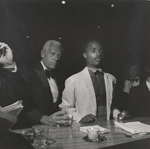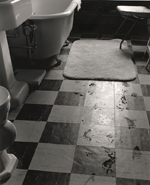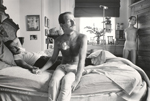On View, 1983-1996
The gallery’s focus on emerging photographers was solidified in 1983 under the directorship of Michael Spano and a newly formed board of advisors made up of significant members of the photographic community, including Helen Gee, Aaron Siskind, Arthur Leipzig, Larry Fink, and Jeffrey Hoone. Although the gallery still occasionally presented new work by photographers with established careers, such as Sidney Kerner or Louis Stettner, the majority of the work presented was by up-and-coming photographers born in the late 1940s or 1950s. The gallery’s typical practice was to feature three photographers, each of whom showed between 25 and 30 photographs, in a single exhibition. The photographers paid a flat fee to the gallery (to cover the cost of printing invitations), and the gallery provided press, mailing, and an opening. Profits from exhibition sales went directly to the photographers, many of whom also donated one or two prints to the gallery’s permanent collection. In 1993, when the Educational Alliance took over the Midtown Y, the gallery moved to 197 East Broadway. Tighter administrative controls at the new location, the appearance of new venues for photography, and increased competition for dwindling state and national funding for arts programs resulted in the closing of the gallery in 1996.
Louis Stettner (b. 1922)
Untitled, ca. 1950–1951
Included in the exhibition Recent Photographs by Louis Stettner, March 3–March 27, 1983
From the exhibition press release dated March 1983:
Louis Stettner’s . . . photographs . . . are from his ongoing series: Landscapes, Portraits, Still Lives, Nudes and Street Life. Mr. Stettner is interested in simple, ordinary artifacts and events of everyday life. By eliminating all extraneous information, he interprets what he sees with compassion and clarity. He has an acute perception of light and his work is exquisitely printed.
 William E. Williams (b. 1950)
William E. Williams (b. 1950)
Untitled, ca. 1981–1982
Included in the exhibition Philadelphia Parties and Portraits, October 6–October 30, 1983
From the exhibition press release dated October 1983:
William E. Williams’ “Philadelphia Parties and Portraits” Black and White Photographs were made over a period of 2 years with a 2¼" format camera using various focal length lenses and electronic flash. The subject of his portraits is the interaction of people with each other or their interaction with the camera. The pictures were all made in public places with the idea of photographing people as they are, at events they have decided to attend. Mr. Williams photographs with an unobtrusive style.
Arlene Gottfried (b. 1950)
“Johnny”
Included in the exhibition Photographs by Arlene Gottfried, October 6–October 30, 1983
From the exhibition press release dated October 1983:
Arlene Gottfried’s 35 mm Black and White photographs are selected from 5 years of photographing people on the street. She photographs with a direct and confrontational style and has compassion for her subjects. Miss Gottfried’s subjects are individuals grasping onto their identity through the institution of some sort of activity or event; be they dancers, lovers, drug addicts or young rebels, they are always on the fringe of society.
Janice Lipzin
Untitled
Included in the exhibition Quince Anos, December 15, 1983–January 15, 1984
Robert Kozma (b. 1951)
Untitled
Platinum and palladium print
Included in the exhibition Platinum and Palladium, January 19–February 19, 1984
From the exhibition press release dated January 1984:
Robert Kozma’s urban landscapes are 8 x 10" platinum and palladium processed contact prints of New York City’s architectural vernacular. He will also exhibit still life and female nude photographs in these non-silver methods. Kozma conducted workshops in these processes at Parsons School of Design and Pratt Institute, NYC.
Fran Shalom (b. 1953)
Untitled
Chromogenic print
Included in the exhibition Two Photographers, March 22–April 22, 1984
From the exhibition press release dated March 1984:
Fran Shalom’s group of Color Photographs are atmospheric, gestural views of the physical world. People walking through misty roads; hands cleansing fish by ancient faucets; green grass being pulled apart, exposing dark moist brown soil.
David McGlynn (b. 1957)
Untitled
Chromogenic print
Included in the exhibition Extended Frames, May 3–June 3, 1984
From the exhibition press release dated May 1984:
David McGlynn’s grid format pictures are 35 mm color contact prints of panoramic images. These images range from precise cityscapes which take in spans of 360˚ by 130˚ to loose, blurry landscapes.
Merle Steir
Untitled
Chromogenic print
Included in the exhibition Extended Frames, May 3–June 3, 1984
From the exhibition press release dated March 1984:
Merle Steir’s color portraits are close up views of sections of facial anatomy photographed from a variety of scale relationships and perspectives. These portraits are assembled asymmetrically to create a unique photograph.
Geoffrey Biddle (b. 1950)
Untitled
Included in the exhibition Loisaida: The Spanish Lower East Side Photographs, September 20–November 4, 1984
From the exhibition press release dated September 1984:
Geoffrey Biddle’s black and white and color “LOISAIDA” photographs depict the hard, bare reality of the Lower East Side. The photographs are about the persistence of basic humanity—warmth and dignity—in devastated circumstances. Biddle says “the primary distraction from life’s travails is the streets, with its relative amount of space, the violent excitement and financial rewards of its illegal commerce, and its completely visible status. There is little privacy, and everyone knows everyone else.”
John Lueders-Booth (b. 1954)
“Jean, Framingham Prison for Women,” 1979
Included in the exhibition Photographs by John Lueders-Booth, January 17–February 17, 1985
Ed Grazda (b. 1947)
“Jegdaleg, Afghanistan, 1983”
Included in the exhibition Photographs by Ed Grazda, February 21–March 24, 1985
Scott Areman (b. 1959)
“Mrs. T. Markoe Robertson”
Included in the exhibition An Old Guard Portfolio, June 6–August 4, 1985
From the artist’s statement:
These portraits document the descendents of the families who formed the summer colony in Southampton, Long Island. The last of the “Old Guard” they represent a way of life that had a strong influence on the character of this Oceanside village.
A bridge between the old and the new these people bear witness to how quickly the present becomes the past, the future is upon us. […] In short, their lives span the transition from the “gilded” age of late nineteenth century to the more egalitarian mass culture that pervaded after World War Two. Ironically the presence of “Society” in Southampton led the way for the influx of “new” people and the changes that have taken place there.
In the wake of such growth they are the last tie to an era when the community was free from the pressure of rapid development and exploitation. Through their experiences we may capture a glimpse of old Southampton. Thus creating a context in which to understand the changes that are taking place, not only there, but in our culture as a whole. This is important so that new ideas and new people can be incorporated into any community without destroying the very things that draw people there in the first place.
Dory E. Thanhauser (b. 1957)
Untitled
Chromogenic print
Included in the exhibition Photographs by Dory E. Thanhauser, June 6–August 4, 1985
From the artist’s statement:
These images were made at Brighton Beach Baths, a beach club in Brooklyn. The subject of these pictures is the senior citizen membership there. Most of these women are jewish, widows, and first or second generation Americans. These are women who are aware that they are growing old; their bodies are deteriorating, their stamina is waning, and their friends are dying. This is a difficult time. But at the Baths, they put on their costumes, make up their faces, and surround themselves with people they have known for years. People who are haunted by the past, scared of the future, and yet, enjoying themselves. They exist in a strange tense—the combination of the past idealized and the present maximized. The band strikes up at three o’clock every afternoon; the women choose their dancing partners and once again are free to become people they never really were. The presence of a camera, another prop, adds one more dimension to this play—an outsider to witness, validate, and record this reality.
Joan Albert (b. 1943)
“Martin at 20, May 1985”
Included in the exhibition View Camera Suburban Scenes, December 12, 1985–January 19, 1986
Douglas Sandhage (b. 1947)
“Young Monk at Wat Well, Chaing-Moir, Thailand,” 1983
Included in the exhibition Thailand, February 27–March 30,1986
From the exhibition press release dated February 1986:
Douglas Sandhage’s black and white portraits in Thailand evolved over an eight year period. Returning year after year and traveling through the country, Mr. Sandhage has captured the agricultural landscape and physical reality as people work or stop for a brief moment to be photographed by the itinerant portrait photographer.
Marke Webb (b. 1950)
“Manor, Texas,” 1982
Included in the exhibition Texas Communities, February 27–March 30, 1986
From the exhibition press release dated February 1986:
Marke Webb’s black and white images are mainly portraits and interiors from small communities in Texas, his home state. These photographs receive much of their strength through economy of line and a clear printing technique coupled with a sharp eye for detail and light.
Ann Chamberlain
Two diptychs from the “Interiors” series
Chromogenic and gelatin silver prints
Included in the exhibition Color Interiors, May 15–June 15, 1986
From the artist’s statement:
“Interiors,” a series of photo text pieces, portrays people through the environments in which they live. Each piece is a dual image. The same photo has been printed in black and white and in color. The black and white image is overlaid with text which provides a counterpoint to the photographic image. The text refers to what is outside the frame, the history of the space, as well as the person who ordered the space. The scenes describe the ways we collect things: how we define our meaning through our possessions and how our possessions come to define us.
Henry Horenstein (b. 1947)
“Boxing Night at Harvard Club—Boston, MA”
Included in the exhibition Sports Photographs, June 19–July 27, 1986
Vivian Ronay
Untitled, 1986
Chromogenic print
Included in the exhibition Astoria, November 6–December 7, 1986
From the photographer’s written correspondence with gallery director Michael Spano:
In the Astoria series I tried to take the color for granted, that is, as we walk the streets—on the whole—we are not conscious of color nor do we remember it after we get home. I balanced my color in these prints by the hue of the cement (or steel or asphalt). When the cement is right all the other colors in the photograph are correct. I want the color to be so “natural” that it feels like the soles of our shoes.
I’m getting more interested in light but it is tricky business in color photography not to get too gorgeous or magnificent with light—sunlight in particular. That’s why, perhaps, the night photography is important to me; in the printing of the night image there’s great latitude with the color balance and I can devote more attention to the quality of the light.
Dawoud Bey (b. 1953)
Two untitled photographs
Included in the exhibition Urban Photographs, November 6–December 7, 1986
From the exhibition press release dated November 1986:
Dawoud Bey’s black and white photographs represent the photographer’s ongoing concern with the contemporary urban locale in which the human figure and the surrounding environment are used as components to create pictures rich in human formal interest. The photographs in this exhibition are of New York City, Syracuse, N.Y., Mexico and Puerto Rico.
Roy Colmer (b. 1935)
“Mother and Daughter, Herald Square, NYC, 1984”
Included in the exhibition Photographs of People, January 23–February 23, 1986
From the exhibition press release dated January 1985:
Roy Colmer’s black and white photographs focus on the individual in a crowd who is often disregarded, whether they are street people, office workers, the elderly, or housewives out for a day of shopping. These are the moments caught where nothing is supposed to happen. The ordinary is viewed as a dramatic event, fixed in everyday surroundings the figures spring into being. The vulnerability of the individual in contrast against city structures, inform us of the time and place.
Roy Greer (b. 1939)
Untitled
Included in the exhibition Diana, Snow Pictures, December 11, 1986–January 18, 1987
From the exhibition press release dated December 1986:
Roy Greer’s streetscapes in the winter are black and white photographs made with a Diana type camera. These pictures play brightness of snow against long dark shadows cast from trees and houses on the sidewalks and streets.
Bärbel Scianghetti (b. 1939)
“The Scianghettis,” 1985
Included in the exhibition People of Granby, CT, December 11, 1986–January 18, 1987
Warren Neidich (b. 1952)
Untitled
Included in the exhibition Incorporating T.V., April 2–May 3, 1987
Sidney Kerner (b. 1920)
Untitled
The Miriam and Ira D. Wallach Division of Art, Prints and Photographs, Photography Collection
This photograph is from the same series featured in the exhibition Faces in the Street, April 2–May 3, 1987
From the exhibition press release dated March 1987:
Sidney Kerner’s black and white series of abstract “Faces in the Street” are found in the concrete stone and metal walls of New York. Sidney started photographing people in the late ’30s under the aegis of the Photo League. He is still photographing faces, but now they do not reflect the economic and social environment, but are simply reflections of his inner self.
Takagi Madoka (b. 1956)
Two untitled photographs
Platinum and palladium prints
Included in the exhibition Platinum Portraits, October 1–November 8, 1987
From the exhibition press release dated October 1987:
Madoka’s 8 x 10" view camera, platinum and palladium contact prints are self portraits where she places herself within the studio or landscape space accompanied with a seemingly close friend. Madoka speaks of these photographs as “the articulation of my current emotional state.”
 Abelardo Morell (b. 1948)
Abelardo Morell (b. 1948)
“Footprints,” 1987
Included in the exhibition Still Lifes, September 22–October 23, 1988
From the exhibition press release dated September 1988:
Abe Morell, a recent father, photographs from the perspective of a toddler. Pointing his camera up from the floor suggests a child’s view in the landscape of their apartment where corridors become huge passageways and building blocks transformed into skyscrapers.
John Milisenda (b. 1947)
Untitled
Included in the exhibition Portrait of My Brother, September 22–October 23, 1988
From the artist’s statement:
The subject of my photographs is my own family: my parents and retarded brother. I have been photographing them continuously from 1968 to present. The photographs avoid easy interpretation. They capture the paradoxes and mysteries of my family’s dynamics. They are also projections of my own fluctuating feelings toward my family: a balance between light and dark, closeness and alienation.
Mary Kocol (b. 1962)
Untitled, 1988
Chromogenic print
Included in the exhibition Interiors, March 23–April 23, 1989
From the exhibition press release dated March 1989:
Mary Kocol’s photographic interest lies within the manipulation of light and color during long timed exposures to produce unusual interpretations of the interior space. She uses a mixture of ambient light, color reciprocity failure coupled with strange camera placement to dislocate the viewer. Mary describes her pictures as tense, anxious and frightful places where she once lived.
Ari Marcopoulos (b. 1957)
Untitled, 1991
Included in the exhibition Urban Scenes, January 11–February 11, 1990
From the exhibition press release dated January 1990:
Ari Marcopoulos’ exhibition consists of black and white street portraits and urban scenes taken in New York City, between 1988 and the present using hand held 4 x 5" and 35mm cameras. This is the first time his work is being shown since the publication of his book “Portraits from the Studio and the Streets” in 1988.
Anderson Scott (b. 1961)
Untitled
Chromogenic print
Included in the exhibition Rural Oddities, February 15–March 18, 1990
From the exhibition press release dated February 1990:
Anderson Scott’s “Color Photographs” of the landscape and small towns in Alabama, Mississippi, Georgia, Louisiana, Tennessee and the Carolinas reveal a strong curiosity for how the past and the present coexist, he investigates how people render themselves and the environment they live in grotesque.
 Sage Sohier (b. 1954)
Sage Sohier (b. 1954)
“David and Eric, Boston, Massachusetts, 1986”
Included in the exhibition At Home with Themselves, September 27–October 28, 1990
From the exhibition press release dated September 1990:
Sage Sohier’s series of photographs and interviews reveal the diversity of gay and lesbian couples as well as the range of their tastes and lifestyles. “At Home with Themselves” is an intimate look into the private lives of couples that captures the mysterious combination of attachment, struggle, and compromise that keeps a couple—whether gay or straight—together.
Timothy Feresten (b. 1954)
“New Haven, CT 1985”
Chromogenic print
Included in the exhibition Color Photographs, March 21–April 21, 1991
From the artist’s statement:
When I began using color materials, in 1983, I worked with many of the same visual concerns which I had explored in black and white. Then, as I continued, color became more important as a subject and the pictures grew more complex. The newest projects mark a clear departure from the more traditional landscape style I employed earlier. It allows me to use color in a more abstract context.
Mary Berridge (b. 1964)
Untitled
Included in the exhibition Teenage Mother Series, April 8–May 9, 1993
Unidentified Photographer
Two untitled photographs
Next Section